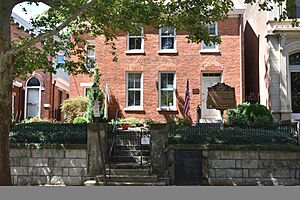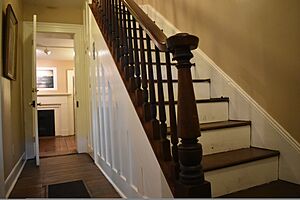Betts House (Cincinnati, Ohio) facts for kids
The Betts House, built in 1804, is a very old and special building in Cincinnati, Ohio. It is the oldest house made of brick in all of Ohio! This historic home helps us learn about Cincinnati's past. It has exhibits and programs that teach about the city's history, how to protect old buildings, and how cities are built. The Betts House is also the main office for a group called The National Society of the Colonial Dames of America in Ohio.
Contents
The Story of the Betts House
The Betts Family's Home
The Betts House was built in 1804. It is the oldest brick house in Ohio. It is also the oldest home still standing in downtown Cincinnati. When it was first built, the house was on a huge farm. This farm was about 111 acres big. It even had a brick yard! Over time, Cincinnati grew bigger and bigger. The farm turned into a busy city neighborhood. Today, the Betts House is an important building in the Betts-Longworth Historic District. This area is in Cincinnati's West End neighborhood.
The first owners were William and Phebe Betts. In 1795, they left their home in New Jersey. They wanted to find new chances in the west. They first lived in Pennsylvania for a few years. In 1800, the family decided to travel west again. They went down the Ohio River on a flatboat. When they arrived, they tried to get land in another town. But the land deal did not work out. So, they came to Cincinnati. Here, William Betts got 111 acres of land. He got it because someone owed him money. Building started quickly on a two-room farmhouse. It was finished in 1804.
For many years, four generations of the Betts family lived in this house. More than two dozen children grew up within its walls! To make room for the growing family, the house changed a lot. Between 1804 and 1864, the house became more than twice its original size. During this time, Cincinnati was also growing fast. The area around the house became a busy city neighborhood.
In 1833, the large farm land was divided up. This happened when William's youngest daughter, Eliza, turned 21. By 1839, the neighborhood was part of Cincinnati. The city kept growing. Almost every piece of land in the West End was built on. The area became very crowded. By the 1870s, the neighborhood was packed with people. The air was also dirty because of nearby factories. Many people, including the last Betts family members, moved to cleaner areas. They went to hillside suburbs like College Hill.
Challenges and Changes
The West End neighborhood became less crowded over time. But soon, many African Americans moved to the area. By the early 1900s, the West End was a lively cultural center for African Americans in Cincinnati. It was known for its fun nightlife. A famous jazz club called the Cotton Club was in this neighborhood. It was named after the well-known Cotton Club in Harlem.
Sadly, this lively time did not last forever. By the 1950s, Cincinnati was changing. Many people moved to suburbs outside the city. To make the downtown area better, the City Council made a plan. They decided to build a new highway. A neighborhood called Kenyon-Barr was chosen for the highway. Between the late 1950s and early 1960s, nearly 1,000 buildings were torn down. This was part of a plan to improve the city. Many people who lived there had to find new homes.
In the years that followed, the West End faced tough times. Many old homes, like the Betts House, were empty for a long time. This was during the 1970s and 1980s.
Saving the Betts House
In 1988, a woman named Martha Tuttle stepped in. She was a descendant of William Betts. She gathered a group of people who wanted to save the house. Two years later, in 1990, they were able to get the house. They worked hard and spent a lot of money to fix it up. After the repairs, the Betts House was used as a small apartment building for a few years.
In 1994, a group called The National Society of Colonial Dames of America in the State of Ohio (NSCDA-OH) became the full owners. In 1996, the Betts House opened to the public. It became a historic house museum. It teaches visitors about how buildings are made and about early Cincinnati history. The house also serves as the main office for the NSCDA-OH group.



